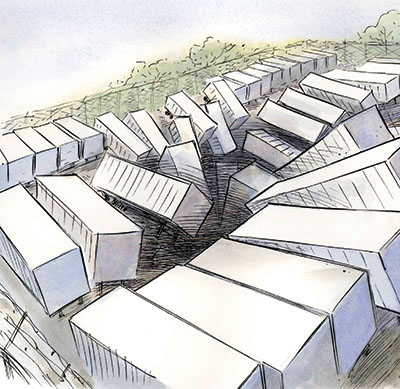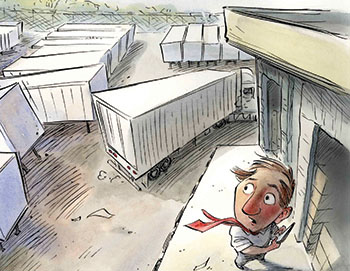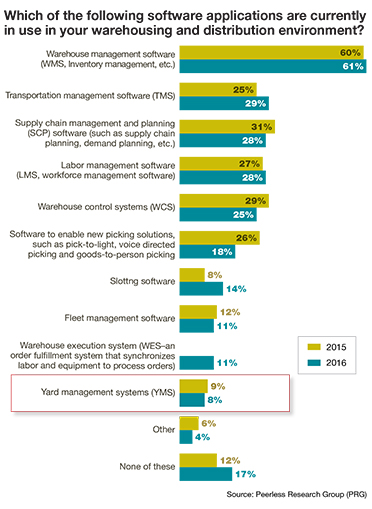Is Your Tractor Trailer Yard a Black Hole?
While adoption rates have remained relatively flat, yard management systems (YMS) are helping logistics operations turn that important space between the loading dock and the gate into a vital link in the supply chain.

Individually, every one of these scenarios can create bottlenecks for shippers that are trying to get products in and out of facilities as quickly, accurately and safely as possible. Unfortunately, without the right accountability and visibility tools, being able to spot and address these issues efficiently becomes somewhat of a crapshoot.
Add in the fact that many shippers still rely on clipboards, physical counts and phone calls to keep the yard running smoothly, and it’s easy to see why some look at this link in the supply chain as a veritable “black hole.”
The space between
Charged with overseeing the movement of trailers and trucks in the yard of a warehouse, DC, or manufacturing facility, yard management systems (YMS) are helping logistics operations overcome these challenges and streamline the activities that take place in that space between the loading dock and the gate.
By helping to prioritize freight arrivals, keep tabs on vehicle locations within the yard, identify the contents of those vehicles, prevent bottlenecks and cut down on unnecessary vehicle movements, YMS helps shippers improve visibility out in the yard—a sector that isn’t always covered by the warehouse management systems (WMS), and rarely by transportation management systems (TMS) or enterprise resource planning (ERP) systems. Using YMS, previously difficult tasks such as locating missing vehicles, expediting deliveries and identifying “black hole” problem areas become easier to manage.
Calling YMS an “add-on module for WMS,” Steve Banker, vice president of ARC Advisory Group’s supply chain and logistics consulting team, says he’s not seeing any significant changes in the adoption rates for yard management solutions right now. “We’re seeing a slow, steady growth for this software sector,” says Banker, “with no real momentum in either the positive or negative direction, in my opinion.”
Banker says he sees more room for innovation within the YMS space, where everything from flying drones to mobile technologies to the Internet of Things (IoT) are working together to construct what could become the “yard of the future.”
 YMS provider PINC, for example, introduced an autonomous drone for the supply chain and logistics industry in 2014. And while the day when we see multiple airborne drones buzzing above the nation’s retail, distribution and manufacturing yards is probably still a few years off, such innovations are prompting shippers to rethink the way they identify and track inventory outside of the four walls of the warehouse.
YMS provider PINC, for example, introduced an autonomous drone for the supply chain and logistics industry in 2014. And while the day when we see multiple airborne drones buzzing above the nation’s retail, distribution and manufacturing yards is probably still a few years off, such innovations are prompting shippers to rethink the way they identify and track inventory outside of the four walls of the warehouse.
“We’re seeing the mobility and IoT side of the YMS industry picking up in terms of new offerings, but I think we’re still pretty early on that side of things,” says Banker, who points to the cold and frozen food sector as one that’s particularly well positioned to take advantage of innovations on the YMS front.
“In the old days, yard management basically meant someone would physically go and look at a trailer, see what its temperature was, and make sure nothing in the truck had gotten too cold or too hot,” Banker explains, noting that in many cases, trucks are “stored” out in the yard with their products still packed inside. This is particularly true during overflow situations, when there isn’t enough room in the warehouse and/or at the dock to accommodate the number of vehicles coming into the yard.
Fast-forward to 2017, and YMS has made the arduous task of physically checking every reefer to make sure the food hasn’t spoiled much easier. Using an RFID tag adhered to the truck and a YMS platform, shippers can use a single, digital dashboard to read sensor data from multiple vehicles. “The YMS takes the data and automatically broadcasts it out,” says Banker, “so someone doesn’t have to walk around with a clipboard through a massive yard of vehicles trying to collect the data by hand.”
Straightening out the pinch points
In assessing the top benefits associated with YMS usage, Banker says that the key returns come in the form of better operational efficiencies.
“A lot of warehouse yard facilities and dock doors are pinch points for companies,” says Banker. “It’s about being able to properly time the dock door scheduling and making people show up on time and then fully utilizing those dock doors.”
 Orchestrating that dance isn’t always easy to do without technology, particularly in today’s e-commerce and omni-channel distribution environment. However, when you add YMS to the mix, the ROI becomes apparent pretty quickly. There are also other soft benefits to using YMS, says Banker. “Where the ROI itself lies in the operational efficiencies and the better utilization of the dock doors,” he points out, “you also don’t really want people walking around with paper-based systems, trying to take notes and in danger of getting hit by a truck.”
Orchestrating that dance isn’t always easy to do without technology, particularly in today’s e-commerce and omni-channel distribution environment. However, when you add YMS to the mix, the ROI becomes apparent pretty quickly. There are also other soft benefits to using YMS, says Banker. “Where the ROI itself lies in the operational efficiencies and the better utilization of the dock doors,” he points out, “you also don’t really want people walking around with paper-based systems, trying to take notes and in danger of getting hit by a truck.”
Norm Saenz, managing director at supply consultancy St. Onge Co., says that on the YMS front he’s seeing continued interest in the use of RFID tags for managing inventory out in the yard. And while software vendors continue to enhance their offerings, he says the basic “put an RFID tag on a trailer and use a YMS to identify and track it” approach to yard management continues to prevail across most industries.
“As companies try to get better turns on their inventory, getting the goods out of the yard and into the building—and then back out again—continues to be a focal point for most shippers,” says Saenz, who sees the potential for drone usage in the yard, but notes that the unmanned flying machines have yet to make much of an impact in that area.
For the most part, Saenz says that most of the clients he’s been working with lately are more focused on the activities taking place within the four walls of their warehouses—and less concerned about what’s going on out in the yard, hence the “black hole” nickname. “Most companies don’t think about YMS as a top priority,” he says. “In fact, at this point, we’re seeing much less focus on yard management versus adopting WMS to manage the movement of people and materials within the building itself.”
Calling YMS one of the potentially “low-hanging fruits” of the supply chain software world, Saenz says the company that wants to do a better job of managing their yard assets, improve inventory turns and get vehicles loaded and unloaded in a more timely fashion, would see some key benefits from its YMS investment.
Within the grocery industry, for example, Saenz is working with one company that’s interested most in daily loading and unloading versus storing trucks in the yard.
“This shipper certainly needs some kind of dock assignment methodology to get trucks to the proper door and get them unloaded, but that really doesn’t require any kind of advanced solution at this point,” says Saenz. “It’s something you can still handle with a combination of spreadsheets, advance shipping notice and instructions to the gate guard on where the truck needs to go.”
What’s the outlook?
Over the next few years, Banker says he doesn’t expect the YMS sector to post a lot of growth, although he admits that there is a valid argument for having a modern-day YMS integrated into both WMS and TMS. With all three systems aligned and working toward the same end game, for example, he says shippers can gain efficiencies both in terms of better utilization of dock door space and improved usage of the yard itself.
“A YMS that’s tightly integrated with WMS, and that understands what’s happening at the staging area [e.g., the DC or warehouse], would arguably help a shipper get more out of its warehouse,” says Banker. “On the other side, a YMS that’s better integrated with TMS can schedule doors to ensure that trucks don’t show up at a time that doesn’t make sense. This is just one way that shippers can get more out of their existing supply chain software investments.”
Saenz adds that drones could factor into the yard of future, but whether that actually happens will depend on which firms decide to take that first step and use those airborne vehicles for yard management.
“I just don’t know how quickly that’s going to take off,” quips Saenz. “The Amazons, Walmarts and Targets of the world will likely do it first, but whether they actually make that move or not remains to be seen.”

Article Topics
Magazine Archive News & Resources
Latest in Materials Handling
Registration open for Pack Expo International 2024 Walmart chooses Swisslog AS/RS and software for third milk processing facility NetLogistik partners with Vuzix subsidiary Moviynt to offer mobility solutions for warehouses Materials Handling Robotics: The new world of heterogeneous robotic integration BSLBATT is looking for new distributors and resellers worldwide Lucas Watson appointed CSO for Körber’s Parcel Logistics business in North America Hyster recognizes Dealers of Distinction for 2023 More Materials HandlingAbout the Author
Subscribe to Materials Handling Magazine

Find out what the world's most innovative companies are doing to improve productivity in their plants and distribution centers.
Start your FREE subscription today.
April 2024 Modern Materials Handling

Latest Resources










